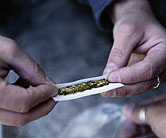
TUESDAY, April 14, 2015 (HealthDay News) — Drinkers who smoke marijuana as they imbibe are twice as likely to drive drunk compared with people who stick to alcohol alone, a new study reports.
These “simultaneous” users are also three times more likely to face social troubles as a result of drinking and marijuana — drunken brawls, broken marriages, damaged relationships and ruined careers among them.
“There are a lot of problems related to alcohol, and marijuana seems to potentially enhance the effects of alcohol in causing these problems,” said study co-author William Kerr, associate director of the Alcohol Research Group.
Many states have authorized medical marijuana use, and four — Colorado, Washington, Oregon and Alaska — have legalized recreational pot.
“If cannabis use becomes more prevalent as U.S. states and other countries continue to legalize it, then we need to be prepared to advise people appropriately,” said lead author Meenakshi Subbaraman, an associate scientist at the Alcohol Research Group. “If you use both substances together, your risk of drunk driving, and possibly other consequences, may be higher than if you stick to using one at a time.”
Drugs like marijuana and cocaine are involved in about 18 percent of motor vehicle driver deaths, according to the U.S. Centers for Disease Control and Prevention. These other drugs are often used in combination with alcohol at the time of the accident.
Marijuana legalization advocates respond that people have long known that combining alcohol and pot is a bad idea, causing users to become much more impaired than if they indulge in either alone.
“NORML has been publicly expressing this caution for years,” said Paul Armentano, deputy director of NORML, an advocacy group that supports the legalization of marijuana. “Research indicates that the combined use of both substances often possesses an additive adverse effect on driving performance and accident risk.”
In the current study, researchers analyzed data from 2005 and 2010 national surveys on alcohol use. The surveys involved almost 9,000 people from across the United States.
The researchers compared three groups of alcohol drinkers. The first group stuck only to alcohol, the second also used pot but always separate from alcohol, and the third group usually used the two substances together.
The vast majority of drinkers — 89 percent — stuck to alcohol alone, while 11 percent reported that they had also used pot, researchers report.
About 4 percent of those who’d used both said they always used them separately, and 7.5 percent said they usually imbibed in both simultaneously.
“It was interesting to me to see that if you use both substances, it looks like you’re nearly twice as likely to use them together than separately,” Subbaraman said.
Simultaneous users also were more apt to be male. They were also more likely to drink very heavily, compared with people who stuck to booze alone, or who used alcohol and marijuana separately.
The results showed that simultaneous users were almost six times more likely to binge drink at least once a month, compared with people who only drank alcohol. People who drank alcohol and used pot separately were nearly twice as likely to binge drink, which was defined as five or more drinks in a day.
Responses to questions about alcohol-related problems revealed that simultaneous users were more than twice as likely to drive drunk than alcohol-only users, the study reported.
Simultaneous users also were nearly three times more likely to suffer social consequences from their alcohol use. These incidents included physical fights and heated arguments, relationship discord, lost career opportunities, brushes with the law, illness, and drinking-related accidents.
These risks held even after researchers adjusted for factors such as gender, age, employment, education and relationship status, Kerr said. The researchers even controlled for lack of impulse control, using the data for binge drinking and average daily number of drinks.
Results like these show that states need to weigh heavily the potential consequences of legalizing marijuana, said Erik Strickland, government relations manager for the Governors Highway Safety Association.
“As an association, we’re trying to help our members figure what to do as more states are taking up marijuana for recreational and medicinal use,” Strickland said. “Just because it’s legal doesn’t mean it’s safe to use and then operate a vehicle.”
No one should think it’s safe to drive after using either alcohol or marijuana, much less the two combined, Armentano said. NORML discourages driving under the influence of marijuana, but noted that alcohol is by far the largest contributor to traffic accidents.
“Greater public education efforts ought to be taken to raise awareness of the fact that this behavior poses a legitimate traffic safety threat and ought to be strongly discouraged,” Armentano said.
The study appears in the May 2015 online issue of the journal Alcoholism: Clinical & Experimental Research.
More information
For more information on impaired driving, visit the U.S. Centers for Disease Control and Prevention.
Copyright © 2025 HealthDay. All rights reserved.

